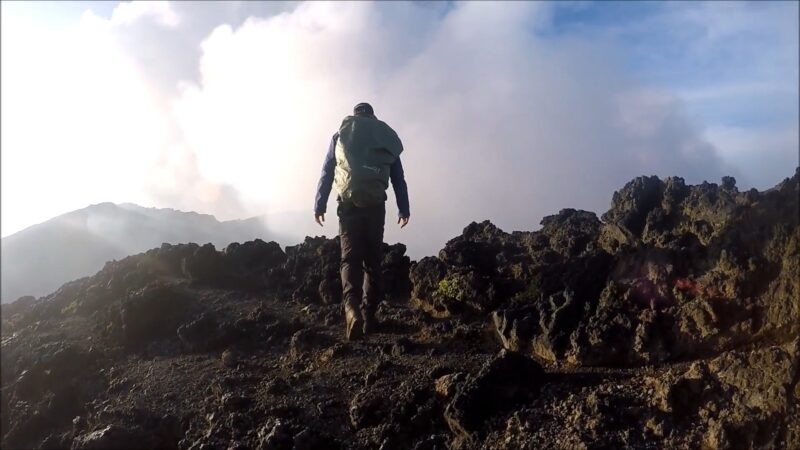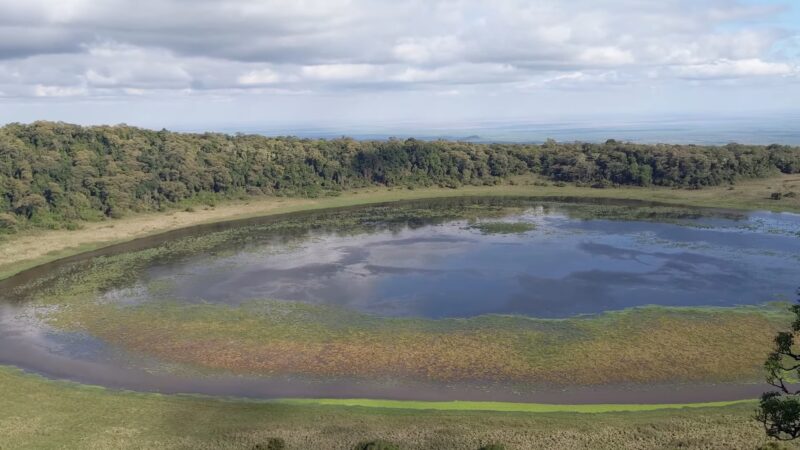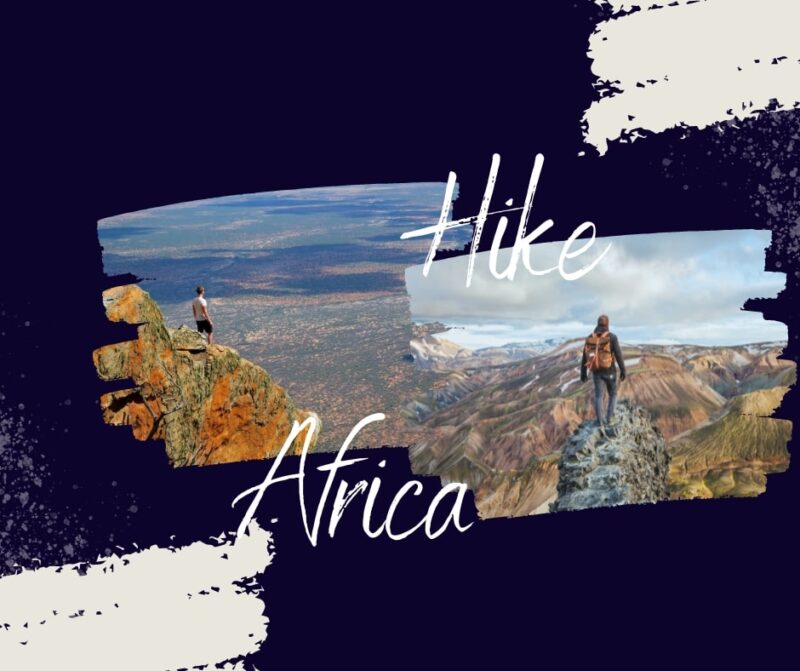East Africa is renowned for its stunning landscapes and rich cultural heritage, but it’s the breathtaking mountains that make it a paradise for hikers. From the majestic heights of Mount Kilimanjaro to the underrated gems like Mount Elgon, the region offers a host of challenging and rewarding hiking experiences.
If you’re an adventure seeker like me, longing for an unforgettable journey, here are 10 mountains in East Africa you should consider adding to your hiking bucket list.
1. Mount Kilimanjaro – Tanzania
Mount Kilimanjaro, also known as the “Roof of Africa,” is the highest mountain in Africa and one of the most iconic in the world. At an impressive 5,895 meters, its snow-capped peaks offer a stark contrast to the surrounding savannah.
- Hiking Experience: The hiking journey on Kilimanjaro is a metaphor for life itself – challenging, rewarding, and transformative. It usually takes around 6-9 days, depending on the route you choose. Among the six official routes, Marangu and Machame are popular choices, each offering unique landscapes.
- Unique Attractions: The mountain’s different zones, from the cultivated lower slopes to the icy summit, offer a varied tapestry of ecosystems. The lush rainforests, moon-like desert landscapes, and gleaming glaciers are awe-inspiring sights to behold.
- Best Time to Hike: The best time to ClimbingKilimanjaro is during the dry seasons – from January to mid-March and June to October . These months offer the most favorable conditions for summiting. The people who climbed say that these months are known for their splendid weather – skies so clear you feel you can touch the stars, breathtaking vistas at every turn, barely a drop of rain, and the sun casting its warm glow over the rugged landscape.
- Tips: Remember, the altitude poses a challenge, so slow and steady wins the race. Acclimatization is key, and taking diamox could be considered to mitigate altitude sickness.
Climbing Kilimanjaro becomes a metaphor for life’s challenges, teaching lessons of resilience, preparation, and the joy of reaching summits both tangible and intangible. Embrace this adventure with enthusiasm, respect for nature, and a spirit of exploration that transcends the climb itself.
2. Mount Kenya – Kenya
Mount Kenya, Africa’s second-highest peak, is an extinct volcano with a series of jagged peaks and high-altitude moorland. Its highest peak, Batian, stands at 5,199 meters, followed by Nelion (5,188 meters) and Lenana (4,985 meters).
- Hiking Experience: The hike can take anywhere between 4-7 days. The most popular routes are the Naro Moru and Sirimon, both providing spectacular views. While Batian and Nelion require technical climbing skills, Point Lenana is accessible for mountaineers.
- Unique Attractions: It’s not just the peak but the journey that captivates. The bamboo and high-altitude moorlands, the wildlife – including elephants and buffalos, and the alpine vegetation like the unique giant lobelia and groundsels plants are unforgettable sights.
- Best Time to Hike: The ideal times to ascend Mount Kenya are during the dry seasons, between December and March and July to October.
- Tips: Like Kilimanjaro, proper acclimatization is crucial. Ensure you have proper gear, including cold weather gear, as temperatures can drop significantly, especially at night.
3. Mount Meru – Tanzania
Mount Meru, the second-highest peak in Tanzania, is a beautiful but often overlooked mountain. With its summit standing at 4,566 meters, it’s a fantastic acclimatization hike for Kilimanjaro and a worthwhile trek in its own right.
- Hiking Experience: A four-day trek will take you through diverse vegetation zones and past a spectacular volcanic crater. The final ascent to Socialist Peak is challenging, but the sunrise views of Kilimanjaro make it worthwhile.
- Unique Attractions: Meru’s lower slopes are home to a diverse range of wildlife. While ascending, you might spot buffalos, giraffes, elephants, and even leopards.
- Best Time to Hike: The best time to climb Mount Meru is from June to February, although it’s possible to climb all year round.
- Tips: Always hike with an armed ranger due to the wildlife presence. Also, acclimatization is important to enjoy the hike to the fullest.
4. Rwenzori Mountains – Uganda
The Rwenzori Mountains, often referred to as the “Mountains of the Moon,” straddle the border between Uganda and the Democratic Republic of Congo. They offer an otherworldly experience with the highest peak, Mount Stanley, reaching up to 5,109 meters.
- Hiking Experience: Rwenzori offers a unique trekking experience that could take anywhere from 7-10 days. Hikers generally traverse the Central Circuit, which winds around the Bujuku Valley, offering stunning views.
- Unique Attractions: The hike will expose you to fascinating ecosystems, including bamboo forests, moss-draped heather zones, and alpine moorlands. The flora is strikingly diverse, with giant heather plants and endemic Lobelia species.
- Best Time to Hike: The optimal times for trekking are during the dry seasons, from December to February and June to August.
- Tips: Be prepared for rainy conditions, as Rwenzori is known for its unpredictable weather. Good waterproof gear is essential.
5. Simien Mountains – Ethiopia
Simien Mountains, or “Chess pieces of the gods” as the locals call them, are a UNESCO World Heritage Site in Northern Ethiopia. The highest peak is Ras Dejen, at 4,533 meters.
- Hiking Experience: Hiking can range from a few days to a couple of weeks, depending on the chosen route and personal preference. The scenery along the trails is incredibly diverse and beautiful.
- Unique Attractions: It’s not only about the spectacular cliffs and gorges. The park is rich in wildlife, with chances to spot Gelada baboons, Walia ibex, and Ethiopian wolves.
- Best Time to Hike: The best time to visit is between October and March, when the weather is more manageable.
- Tips: Hire a local guide or join a group trek for the best experience. Don’t forget to carry warm clothes as temperatures can drop at night.
6. Mount Elgon – Uganda/Kenya
Straddling the Uganda-Kenya border, Mount Elgon, an extinct shield volcano, is less frequented, but it holds a world of charm. The highest point on the Ugandan side is Wagagai peak at 4,321 meters.
- Hiking Experience: The journey could take anywhere from 5 to 7 days, traversing through dense montane forests and mixed bamboo belts.
- Unique Attractions: One of the highlights is the caldera, one of the world’s largest. It’s also home to an array of wildlife, including over 300 species of birds, elephants, and various monkey species.
- Best Time to Hike: The best periods to visit are during the dry seasons, from June to August and December to March.
- Tips: As with other East African treks, it’s advisable to have a guide for safety and to better appreciate the ecology of the mountain.
7. Mount Hanang – Tanzania
Mount Hanang, located in the Manyara region of Tanzania, is an extinct volcano standing at 3,418 meters. Though lesser known, Hanang offers a captivating trek away from the more popular tourist trails.
- Hiking Experience: A round-trip hike typically takes two days, with the first day devoted to the ascent and the second to descent. The climb involves navigating steep and rugged terrains.
- Unique Attractions: The mountain is rich in bird life and provides spectacular views of the Rift Valley, Lake Balangida, and the distant Sanu Mountains.
- Best Time to Hike: You can hike Mount Hanang throughout the year. However, the dry seasons from June to October and December to March are most favorable.
- Tips: Local guides are essential for navigating mountain paths and enhancing the experience with their knowledge of the local ecosystem.
8. Mount Karisimbi – Rwanda/DRC

Mount Karisimbi is the highest of the eight volcanoes in the Virunga Mountains, straddling Rwanda and the Democratic Republic of Congo. Standing at 4,507 meters, it’s an exceptional but challenging hiking destination.
- Hiking Experience: The trek usually takes two days, with the first day dedicated to climbing to the base camp and the second to reaching the summit and descending. The trek involves navigating through thick bamboo forests and steep slopes.
- Unique Attractions: Besides the panoramic view of other volcanoes and the sprawling landscapes, you might get to see the famous mountain gorillas along the trek.
- Best Time to Hike: The best time to hike is during the drier months, from June to September and December to February.
- Tips: You’ll need a guide for this hike. Also, pack warm clothes, as the summit can get quite cold.
9. Mount Sabinyo – Uganda/Rwanda/DRC
Mount Sabinyo, at 3,669 meters, is an extinct volcano located in the Virunga Mountains. It’s one of the only places in the world where you can stand in three countries at once – Uganda, Rwanda, and DRC.
- Hiking Experience: The hike usually takes a full day. It’s challenging due to steep, slippery trails and multiple ladders to climb.
- Unique Attractions: Each of the three peaks offers a different, magnificent view of the three countries. Plus, you might get a chance to see mountain gorillas and golden monkeys in the nearby forests.
- Best Time to Hike: The best time to hike Mount Sabinyo is during the dry seasons, from June to August and December to February.
- Tips: Wear good hiking boots due to the slippery nature of the trails. Hiring a guide is necessary and highly recommended.
10. Mount Marsabit – Kenya

Mount Marsabit is an extinct volcano located in the northern part of Kenya. It’s unique for its lush rainforest in the middle of an otherwise arid region.
- Hiking Experience: You can explore Marsabit on day hikes. The trails range from easy to moderate, making it suitable for casual hikers.
- Unique Attractions: The lush Montane forest is a haven for wildlife, including elephants, buffalos, and various bird species. Lake Paradise, a crater lake, is a must-visit site.
- Best Time to Hike: The best time to visit is during the dry seasons, from July to October and January to March.
- Tips: Hiring a guide can enhance your understanding of the local flora and fauna. It’s also advisable to carry plenty of water due to the high temperatures in the region.
Final Words
And there you have it, the top 10 mountains to hike in East Africa. Each offering unique experiences, these mountains provide adventurous spirits an opportunity to connect with nature and challenge themselves physically and mentally.
Related Posts:
- 9 Deserts in Africa: Pics, Maps, Interesting Facts & More
- 10 Hottest States in the US in 2024 - Heatwave Alert
- 10 Climate Change Movies To Watch in 2024: Lights,…
- 10 Best Books on Climate Change in 2024 - In-Depth…
- How Does the Greenlash Impact the Casino Industry in…
- How to Reduce Your Pool's Environmental Impact - 2024 Guide








